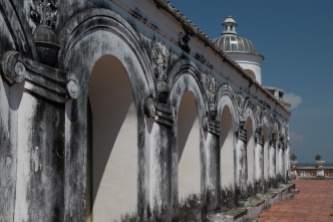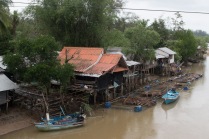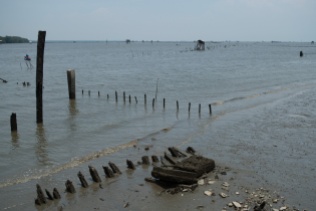Having gone from snow to snow across Europe to the Stans and flown into India, missing the frozen Himalayas, where we cycled for three months in idyllic Indian ‘winter’ weather we’re now back to sizzling temperatures, on our way down south to the equator.
We need to be on the road early; by nine o’clock it’s starting to feel pretty hot and the early cooling, apparent wind is replaced by a healthy head wind as the day progresses. Heat and hills conspire to limit our mileage. Regular drink stops replace the litres dripped along the way until we cower in the shade as temperatures reach the fierce forties. All reducing our progress.
We’ve had to make some choices, keeping to a more direct route rather than the meandering around we did in India, and our backtracking in Myanmar. From Tak, when we were finally through the border mountain range, it was our first real decision time – where to go in Thailand? We knew our exit point would be Thailand’s southern extremity, at the Malaysian border, but how to get there, what to see?
Searching the electronic Lonely Planet guide throws up ‘must see’ places but it seemed that culture was in the northern half of Thailand while numerous National Parks were down south. And, beaches, beaches and more beaches, many offering world class dive sites spanned the length of the east coast while the west coast boasts the best island nature reserves … and yet more beaches.
Directly south led to Kanchanaburi, of ‘Bridge over the river Kwai’ fame whereas slightly further east and then south was the route to the Ayuthaya, the once capital city of Siam and now a vast UNESCO listed temple complex.
We selected the
infamous WW2 site knowing we would catch up on temples in Phetchaburi. Whilst the
‘Bridge over the river Khai’ is a fictional representation made for the big screen it did raise awareness of the plight of many prisoners of war during the making of what is frequently known as Death Railway. Dipping into the history here revealed some horrific tales of abuse, deprivation, torture; a total neglect of any human rights resulting in thousands of deaths in Japan’s pursuit of a land route through from Thailand to Burma. But also, reading about it, and then deeper, leads one into much more understanding of this region’s history than one gets from a traditional “British Empire” historical view. European powers did substantially invade Indo-China – colonies aren’t usually voluntary – so it’s far from a simple narrative of “natives” and “masters” against Imperial Japan. Much of the European expansion was within living memory in 1943. In much of Asia, substantial portions of the colonised saw the Japanese as Asian liberators, an impression the Japanese naturally were keen to propagandise. However, although over 12,000 Allied PoWs were driven to death on the railway, an estimated nearly 10 times that number of Asian impressed labourers also died on it, in even harsher conditions. There are no cemeteries for them.

There’s a cemetary for Chinese soldiers too. Chinese Nationalist army was fighting the Reds and Japan at the same time.

Since the war, a Chinese temple nearby

No cattle wagons: Tourists now cruise through in comfort

The original rounded central spans were bombed out in WW2. Japan provided new ones afterwards.

Loco built 1928 in Glasgow, if memory serves

Lots of Dutch graves here, as well as Commonwealth.

This one struck home! I wonder…
Bangkok had to be done but cycling in major cities is time consuming as there are endless traffic lights, traffic jams and roundabouts and it’s scary with the high density of traffic all impatient to make it to their destination. It wasn’t en-route anyway, so we abandoned our bikes in Kanchanburi in favour of a bus to make the journey in air conditioned luxury.
Bangkok is on several levels. There are sky trains, sky walks and sky motorways criss-crossing the centre of the city. Many sky scraper shopping malls are interconnected by air conditioned walk ways making the shopping experience, whilst hecticly busy, cool at least.

OLYMPUS DIGITAL CAMERA
Bangkok is stuffed full of temples and historical buildings, as you might expect. Thai Buddhist temples are richly decorated, bright, dripping with gold, and always seem to have a fresh coat of paint. The murals inside are usually worth a study too. All the splendour doesn’t imply overformality of use though. As we’ve seen across the east, temples – including mosques – are places to meet and be, as well as worship. While making phone calls during the service isn’t done, there’s plenty of checking for messages. Perhaps they’re all buying devotional gold leaf on eBay?
More temples…

Chinese Temple, Kanchanaburi

Bangkok

Bangkok

Krabi – new temple as yet unpainted
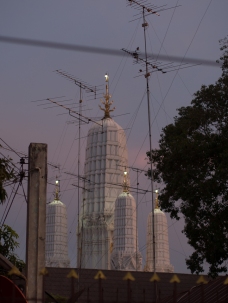
Phetchaburi – Thailand has lots of overhead wires

Phetchaburi

Peninsular east coast. Not certain this structure is religious

Phetchaburi, Summer Palace Temple
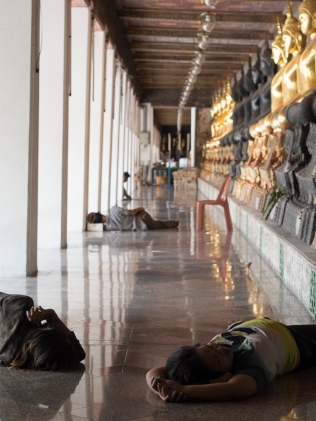
Bangkok, peace in the temple corner, on a busy tourist day

Bangkok

Bangkok. Procession of mourners for Rama IX

Chinese temple, Bangkok

Cave Temple

Cave Temple

Cave Temple

Krabi – decorative plasterwork not yet painted

Bangkok, Mural

Krabi Mural (left of main door)

Krabi Mural (right of main door – spot the different theme)

The temple builders have fun with mirrors, so do we…

Gold leaf everywhere

Mirrors
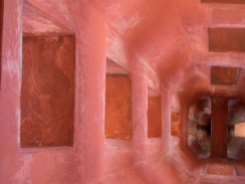
Guess!

Ao Nang Fishermans Cave Shrine. You never saw so many pricks apart from telivised politics

Bangkok
Back on the road and cycling south down the coast of the Gulf of Thailand, we stumbled across the claimed 5th best caving system in Asia. It was indeed spectacular with dramatically lit stalactites and stalacmites, but unbearably hot. Gid couldn’t see much through steamed up glasses, so took them off in the end.
Our second caving experience was to see the cave shrines at Tham Khao Laung, Phetchaburi. Vast open caverns, lit by beams of light penetrating through the roof top onto Buddha images made for a very spiritual aura. The extended cave was again dramatically lit with multicoloured tubes.

OLYMPUS DIGITAL CAMERA

OLYMPUS DIGITAL CAMERA

OLYMPUS DIGITAL CAMERA

OLYMPUS DIGITAL CAMERA

Add some human interest?
Gid decided the cave was a great place to experiment with ICM – Intentional Camera Movement. Posted separately, this blog is getting too big!
Later, still in Phetchaburi, catching up on our palaces and temples, we walked up a hill to visit the breezy summer palace of Thailand’s recent kings.

OLYMPUS DIGITAL CAMERA
Maybe time for a few more general Thailand pictures:

Seems to be a tourist convention covering from Delhi at least to Bangkok

Phetchaburi – pretty typical Thai town. Spot the hills.

Lots going on in the country

A lot of it looks rather like this

On the road. The dot’s Clare.

Krabi, before evening thunderstorm

Krabi, clouds lit up by lightning

How to load a digger, the Thai way.
Culture gave way to beaches and parks as our route took us further south. Both of us were keen to see wild elephants but the odds weren’t looking good. We hoped for more success than on our futile
tiger safari. The Lonely Planet mentioned several places but sightings were all in the lap of the gods until Gid found a small National Park – Kui Buri -whose TripAdvisor reviews ‘guaranteed’ near 100% success rate.
A quick 60km dash back north got us to the reserve but my heart sank, as we set off in the truck, when our guide excitedly exclaimed, ‘There’s an elephant!‘ Disappointment coursed through my body; I couldn’t believe that the trees moving some 30 or 40 metres away in a dense thicket was going to be our sighting. Gradually we saw more and more shapes in the undergrowth until the unbelievable happened. A lone male sauntered out into the open while we were standing on a ridge up above it. Our guide sped us along a footpath to get a better view as it continued dawdling on its way. The moment was capped by a herd of gaur (also known as Indian bison) grazing in a clearing on the other side of the valley. At that point our luck changed. From this sighting we went on to get several more clear views of family groups as well as a pair of elephants who seemed to be on a mission as they sped across a meadow. The finale to our day was 100m from the center when the motor bike a head of us rapidly u- turned, frantically waving us down. Back he went as a herd of elephants, with at least two babies in their midst, alarmed by our close proximity, trumpeted across the road dust flying, some 20 m ahead of us.
For the first time in ages we camped at the park. Although the kit all unfolded fine, and the facilities were adequate it was horribly uncomfortable – way too hot and no airflow. Back in the bags it all went!
Conscious we’d rather screwed up by having backtrack to see the hefalumps, we pored over the map, google, etc, to plot our course. As we went further south, the majority of interest switches to the west coast of the peninsular. Not to mention a wee bit of political violence in Thailand’s extreme south east; one day, maybe, we’ll find another country everyone wants to be in. Not the UK, obviously, although that nice Ms Sturgeon shows no interest in AK47s, fortunately. Anyway, Phuket is the famous Andaman Sea resort, but we aimed a little further south, to Ao Nang, for our beach stop. Blue sea, check. Spectacular limestone islands, check. Golden sandy beaches, check. Following a surprisingly rainy spell, it’s still cloudy and often grey, but hot when the sun gets through, enough to entice some wonderfully wobbly derrieres out of jeans and into, or at least, almost into, itsy bitsy pieces of coloured Lycra (sorry, no pics).
Boats between beaches…

Water monitor spotted on our beach walk.

OLYMPUS DIGITAL CAMERA
We’re planning to linger in Thailand until after the Thai new year on April 13-16. So we’ve hunkered down in the coastal town of Krabi, for a few day’s rest, and to join in the water fights. Apparently it’s a good time to keep off the roads – road casualties double over the period. There’s the same drink driving issues as at home, and also not everyone can concentrate….
Splat!
Travelling the world isn’t what it was. Not only are we frequently referring to the Garmin bike navigator, Kindle’s lightweight version of Lonely Planet’s weighty and dog-eared tomes, online sources, and Google Maps and Open Street Map, but Gid (foolishly?) joined a WhatsApp chat group, which generates a background hum of mostly European gap-yearers on bikes in SE Asia, all discussing the best roads for each segment, and how to get a wheel fixed in rural Cambodia. It’s all good info, but we all seem so unromantically well informed, compared to long haulers tales in books (not blogs!) from the eighties and nineties. Plus many of these smooth asphalt roads didn’t exist back then… So, we make our choices, based on a deluge of information. And skip by so much, waving and crying out, “Can’t stop there this time“. I wonder if there will be another?




































































